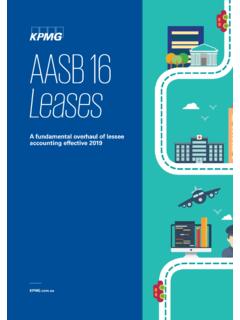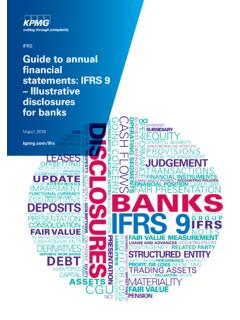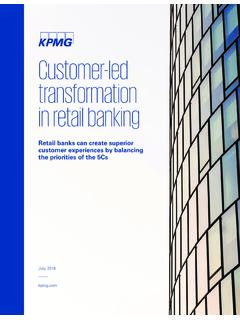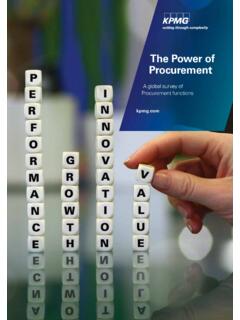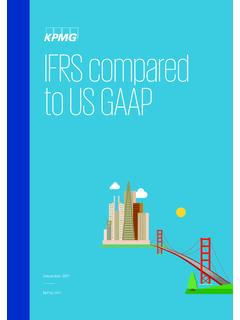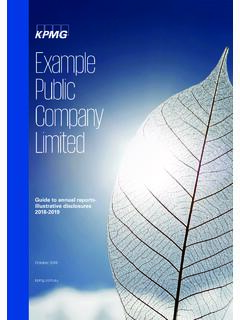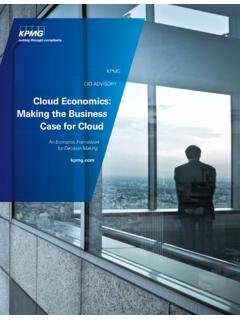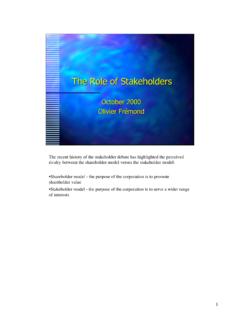Transcription of ESG, strategy, and the long view
1 ESG, strategy, and the long view A framework for board oversight The role of the corporation in society is an abstract, politically polarizing question that is not high on the priority list of most boards. Yet, embedded in this question are strategic and operational issues critical to long- term value creation. And these issues are attracting heightened attention from investors, consumers, and other stakeholders. 56% cite stakeholder expectations as a primary driver of their company's ESG focus. Source: KPMG Board Leadership Center survey, 2017. 2017 KPMG LLP, a Delaware limited liability partnership and the member firm of the KPMG network of independent member firms affiliated with KPMG International Cooperative ( KPMG International ), a Swiss entity. All rights reserved. From our perspective, many of these issues fall In addition to the challenges of short-term pressures and under the broad rubric of environmental, social, and finding a common language, there is no cookie cutter governance (ESG), from climate change impacts and worker approach to ESG.
2 The strategic importance of specific safety to workplace diversity, executive compensation, ESG issues can vary widely by company and by industry. and board composition. Given the significant opportunities A company's ESG profile may change as the company's and risks associated with ESG, companies that excel at business changes, and a company's philanthropic activities identifying and incorporating these issues into their strategy captured in a glossy report can create the perception (and enjoy a competitive advantage in the marketplace and among complacency) that ESG is being addressed that the institutional investors. It is increasingly clear that ESG and company is doing its part. In fact, addressing ESG as the ROI are long-term strategic issue that it has become and embedding So why isn't ESG top of mind in every boardroom?
3 It into the company's core business activities (strategy, Too often, the pressures of short-termism from quarterly operations, risk management, and corporate culture) is a earnings reports to investment vehicles valued daily or formidable challenge requiring an understanding of why monthly, to management compensation incentives cause ESG matters to the company's long-term performance, a companies to neglect ESG issues, which, by their nature, clear commitment and strong leadership from the top, and tend to be more long term oriented in the context of strategy enterprise-wide buy-in. and performance. Language can also present barriers, and Companies and boardroom discussions are moving the subject is often difficult to define. Is it corporate social at different speeds in addressing ESG issues today. responsibility (CSR)?
4 Shared value? Conscious capitalism? But wherever a company is on this journey, the board can Triple bottom line? Responsible business? Corporate help lead the organization forward by focusing on the big citizenship? Sustainability? picture. Which ESG issues are of strategic significance to the And context matters. How ESG issues are framed for company? How is the company managing ESG-related risks discussion in the boardroom and across the company and opportunities and embedding ESG into the strategy and will influence whether they are viewed as business issues culture to drive long-term performance? How is the company that are essential to long-term value creation or soft topics telling its ESG story to investors and other stakeholders? that are more marketing and brand/reputation driven. For example, a company's approach to the topic of climate change might be considered politically fraught and relevant primarily to the company's reputation.
5 But a discussion of how long-term risks to manufacturing operations and the supply chain created by severe weather patterns is likely to be more meaningful and productive. ESG. Each company will have its own mix of ESG issues, but for purposes of this paper, ESG . encompasses those that are prominent on investors' and other stakeholders' agendas today and commonly cited in corporate responsibility and sustainability reporting: Climate change impacts Workplace diversity and Labor practices Water and waste management inclusion Executive compensation Natural resource scarcity Talent management Political contributions Product and worker safety Employee relations Board independence, Supply chain management Human rights composition, and renewal Health 2017 KPMG LLP, a Delaware limited liability partnership and the member firm of the KPMG network of independent member firms affiliated with KPMG International Cooperative ( KPMG International ), a Swiss entity.
6 All rights reserved. ESG, strategy, and the long view 1. To help boards understand and shape the total impact of the company's strategy and operations externally on the environment, the company's consumers and employees, the communities in which it operates, and other stakeholders . and internally, on the company's performance, this paper presents a five-part framework: Level setting: Agree on definition of ESG and its importance to the company. Assessment: Determine which ESG risks and opportunities are of strategic significance to the company. Integration: Encourage integration of strategically significant ESG issues into the business strategy. Stakeholder communications: Shape the company's key ESG messages to investors and other stakeholders in the context of strategy and long-term value creation. Board oversight : Ensure that the board has the right composition, structure, and processes to oversee ESG in the context of strategy and long-term value creation.
7 This framework, developed by the KPMG Board Leadership Center in collaboration with Professor George Serafeim of Harvard Business School, will form the basis for deeper dives and case studies in future white papers. 2017 KPMG LLP, a Delaware limited liability partnership and the member firm of the KPMG network of independent 2 ESG, strategy, and the long view member firms affiliated with KPMG International Cooperative ( KPMG International ), a Swiss entity. All rights reserved. Board oversight framework Level setting Agree on definition of ESG and its importance to the company. Assessment Determine which ESG risks and opportunities are of strategic significance to the company. Integration Encourage integration of strategically significant ESG. issues into the business strategy. Stakeholder communications Shape the company's key ESG messages to investors and other stakeholders in the context of strategy and long-term value creation.
8 Board oversight Ensure that the board has the right composition, structure, and processes to oversee ESG in the context of strategy and long-term value creation. Total impact strategy Our framework for board oversight of ESG as a strategic issue recognizes that creating long- term value increasingly requires companies to understand the impact of their strategies on key stakeholders investors, employees, customers, communities as well as on the natural resources and supply chains that the company relies on. Total Impact Strategy encourages companies and boards to widen their aperture for a fuller view of ESG, strategy, and long-term performance. 2017 KPMG LLP, a Delaware limited liability partnership and the member firm of the KPMG network of independent member firms affiliated with KPMG International Cooperative ( KPMG International ), a Swiss entity.
9 All rights reserved. ESG, strategy, and the long view 3. Level setting Agree on definition of ESG and its While we use the term ESG to cover the broad range of environmental, social, and governance issues that importance to the company. are meaningful to investors, employees, customers, and other stakeholders, others may use terms like CSR, sustainability, or corporate citizenship. These terms often mean different things to different people, even those who believe they are speaking a common language. An important first step is for the board to reach an understanding with management not only on language but what that language means as a practical matter. A case in point: Companies often conflate ESG and charitable giving, but giving is just a narrow aspect of the much larger, strategic ESG equation. How ESG issues are framed and discussed has a big impact on understanding why they matter to the business and how to address them.
10 Given the pitfalls and barriers that ESG. language can create, it is important to (re)frame the discussion in business terms particularly risk, opportunity, efficiency, and financial performance. As in our earlier example, climate change can be framed as a discussion about the risks water shortages and droughts pose to a beverage company's manufacturing operations, the potential financial impact these risks pose, and how the company might mitigate these risks in a way that improves bottom-line performance. This strategic approach can help short-circuit preconceptions, politics, and personal views while setting the discussion on the right course at the outset. Given the pitfalls and barriers that ESG language can create, it is important to (re)frame the discussion in business terms particularly risk, opportunity.


